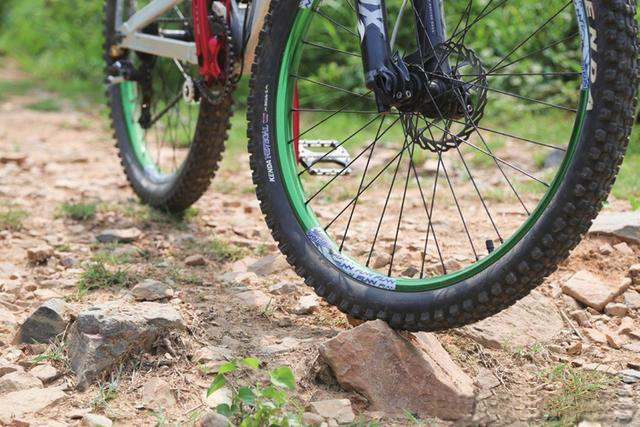It’s about to enter the autumn season, and it’s really cool to ride in the woods!

But if we encounter emergencies such as “snake bites”, punctures, and running air, this will greatly reduce our riding fun. If a tire blows out, in addition to personal safety, it will also cause an impact on the rim.

If you can set the tire pressure that suits you in advance, you will be able to pierce the ditch more and more ridges, as if walking on the ground!

What is the right tire pressure?
Today I will share with you the tire pressure of mountain bikes to solve some questions in the minds of riders

The tires are not always full. If the air pressure is too high, it will make riding feel too hard and uncomfortable, or make the inner tube intolerable and puncture the tire. If the tire pressure is too low, it will make the riding process too laborious. What is the right tire pressure? Do you know the factors that affect tire pressure settings?
Rider’s weight
People have always been the subject of cycling. Whether a tire performs well is closely related to the weight of riders. For example, a rider who weighs 60kg and uses a 26×2.0 mountain tire may find that a tire pressure of 40psi is too hard and lacks grip. On the contrary, if an 85kg rider rides it, the tire pressure will be too low.

A sturdy rider needs a larger tire pressure.
Tire volume
The volume of a tire is a key factor affecting tire pressure, and it determines the overall performance of this tire. For example, 40 psi on a 700×20c (circumference of 2114mm) road tire will feel very flat, but for 27.5×2.3 mountain tires will be very soft, bumpy road will cause damage to the tire.

Mountain bike tire treads are generally marked with the maximum tire pressure, which is usually 65 psi.
Riding style
As riders go from the pure “Mountain Horse Party” style riding to the XC forest road and DH downhill style riding. Your riding style determines whether the road you ride on is soft soil or rock, and different road surfaces also need different tire pressures to adapt to different terrain.
Tire structure
As the focus of riding load-bearing capacity—the quality of the tire will determine its good performance. The TPI value (density of the tire carcass) of the tire determines that you need to use high or low tire pressure to adapt to different tires. TPI value. Usually high-TPI tires are softer than low-TPI tires, but Tubeless (tubeless) or Tubeless ready (quasi-tubeless) tires usually have lower tire pressures. Therefore, it is necessary for riders to find the right tire pressure according to the structure of different tires when riding.

Comparing the TPI value of mountain bikes, you can observe the hardness of the rubber carcass.

The tire pressure of vacuum mountain bike tires is generally between 30-65psi, and its independent Presta valve and low pressure resistance are one of its main features.
After understanding the factors that affect tire pressure, it will be easier to set your own tire pressure. How to set mountain bike tire pressure correctly?
In traditional mountain riding, high tire pressure usually causes the tire to bounce, and if the tire pressure is too low, it is easy to “bite the snake” and puncture the tire. Basically, most XC off-road tires are narrower than AM or DH off-road tires. Therefore, it is recommended to set the tire pressure between 40-60psi. If it is a soft tail car with double shock absorbers, it can usually reach 50-60 psi. For bicycles with single suspension, 45 psi is usually used as the intermediate value, and then it is increased or decreased according to factors such as dry and wet ground, track conditions and soil quality.
It is generally recommended to lower the tire pressure by 1-5 psi in soft, sandy terrain, which can enhance the tire’s grip effect. In hard and rocky terrain similar to DH continuous high-speed downhill, the tire pressure can be slightly higher (plus 5psi), which can increase the passability of the tire and prevent “snake bite” from happening.

Snake bite: Riding in mountainous areas where there are many stones, if the tire pressure is insufficient, it will cause the inner tube to collide with the ground, and then be pierced out of the corresponding small hole.
In the actual mountain bike tire pressure setting, we still need to rely on the increase in experience to properly set the tire pressure. In normal operation, it is necessary to use a barometer to measure tire pressure as much as possible, rather than simply measuring it with fingers.

In most mountain races, we will find that many drivers will set different front and rear tire pressure values. Because the front wheels pay more attention to offensiveness and the rear wheels tend to pass through, generally we recommend that the front tire pressure be set to be about 2-5psi lower than that of the rear wheels.
Hope these mountain bike tire pressure knowledge can solve some of your questions!
Hotebike is selling electric bicycles, if you are interested, please click on hotebike official website to view
 hotebike
hotebike